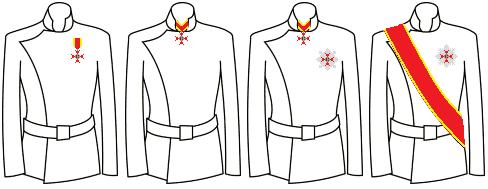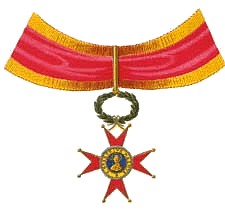Order of St. Gregory the Great
Papal Order of Knighthood of the Holy See From Wikipedia, the free encyclopedia
The Pontifical Equestrian Order of St. Gregory the Great (Latin: Ordo Sancti Gregorii Magni; Italian: Ordine di San Gregorio Magno) was established on 1 September 1831, by Pope Gregory XVI, seven months after his election as Pope.[1]
| Pontifical Equestrian Order of St. Gregory the Great | |
|---|---|
 Knight Commander's cross of the Order of St. Gregory the Great | |
| Awarded by the Holy See | |
| Type | Papal order of knighthood |
| Established | 1 September 1831 |
| Religious affiliation | Catholic |
| Motto | |
| Status | Currently constituted |
| First head | Pope Gregory XVI |
| Sovereign | Pope Francis |
| Classes |
|
| Former grades | Knight/Dame Grand Cross of the Second Class |
| Precedence | |
| Next (higher) | Order of Pope Pius IX |
| Next (lower) | Order of St. Sylvester |
Ribbon bar of the order | |
The order is one of the five orders of knighthood of the Holy See. The honor is bestowed upon Catholic men and women (and certain notable non-Catholics)[2] in recognition of their personal service to the Holy See and to the Catholic Church, through their unusual labors, their support of the Holy See, and the examples they set in their communities and their countries.
History and appointment
The inaugural brief states, in part, that "gentlemen of proven loyalty to the Holy See who, by reason of their nobility of birth and the renown of their deeds or the degree of their munificence, are deemed worthy to be honored by a public expression of esteem on the part of the Holy See". The end of the brief states that they must progressively maintain, by continued meritorious deed, the reputation and trust they had already inspired, and prove themselves worthy of the honor that had been conferred on them, by unswerving fidelity to God and to the sovereign Pontiff.[3]
The awarding of the Order of St. Gregory the Great presents no particular obligations on the recipients toward the Catholic Church – except for the general ones stated above.
Insignia

An eight-pointed cross, the insignia of the order, bears a representation of St. Gregory on the obverse and on the reverse the motto Pro Deo et Principe ("For God and Ruler"). The cross is suspended from a red and gold ribbon. In ecclesiastical heraldry, laymen awarded the high rank of Grand Cross can display a red and gold ribbon surrounding the shield in their personal coats of arms, but the recipients of the lower ranks place an appropriate ribbon below the shield.[4] The difference between the civilian and military insignia is that the former group wears the cross hanging from a green crown of laurel, whereas the latter group wears the cross hanging from a trophy of arms.[5]
Vestments and accoutrements
The Order comprises four classes:
- Knight/Dame Grand Cross (GCSG)[6]
- Knight/Dame Commander with Star (KC*SG/DC*SG)
- Knight/Dame Commander (KCSG/DCSG)
- Knight/Dame (KSG/DSG)
A green uniform was later prescribed by Pope Pius IX. The uniform contains a black beaver-felt hat decorated with black silk ribbons, silver metallic twisted rope, buttons and black ostrich feathers. The jacket, made of green wool, is trimmed with silver metallic thread, and has a tail, nine yellow metal buttons in the front and three buttons on the cuffs and is lined with black satin. Finally, the costume contains suspenders, several yellow and red rosettes, white leather gloves, and a short sword with a handle made of mother of pearl with a medallion of the order at the end.
Knights Grand Cross wear a sash and a badge or star on the left side of the breast; Commanders wear a cross around the neck; and Knights wear a smaller cross on the left breast of the uniform:
 | |||
Notable members

Knight/Dame Grand Cross
- Frederick Blakeney, 1964, Australian diplomat, Knight Grand Cross[7]
- Dominique, Prince de La Rochefoucauld-Montbel, 2023, Knight Grand Cross
- Sir George Bowyer, 6th Baronet, Knight Grand Cross[8]
- General Sir Peter Cosgrove, 2013, Knight Grand Cross, Governor-General of Australia[9]
- João Carlos Saldanha de Oliveira Daun, 1st Duke of Saldanha, Knight Grand Cross of the First Class[10]
- Rodrigo Augusto da Silva, Knight Grand Cross of the First Class
- Baron Henry Delvaux de Fenffe, 1921, Governor of Liège[11]
- Duke Carl Ludvig Fouché d'Otrante (1930)[12]
- George Forbes, 7th Earl of Granard, Knight Grand Cross[8]
- Édouard de Castelnau, French general[13]
- Frank Hanna III, American entrepreneur and philanthropist, Knight Grand Cross
- Alice von Hildebrand, 2013, Dame Grand Cross[14]
- Charles von Hügel, 1852, Knight Grand Cross[15]
- Johno Johnson, 2015, Australian politician[16][17]
- Dina Kawar, previous ambassador of Jordan to France[18][19]
- Riccardo Muti, 2012, Italian conductor, Knight Grand Cross[20]
- Gilbert Levine, 2016, American conductor, Knight Grand Cross[21]
- James Joseph Norris, February 11, 1947, American Catholic humanitarian, co-founder and president of the Papal agency, the International Catholic Migration Commission. European Director of War Relief Services (later Catholic Relief Services). Collaborated with the Holy See for thirty years on refugee resettlement and world poverty. (Also see James Joseph Norris, Knight Commander 1955)
- Juan Domingo Perón, Caballero de la Gran Cruz (28 de Junio de 1947)[22]
- Count Christopher de Paus (1930)[12]
- Count Hippolyte d'Ursel
- Count Léo d'Ursel, ambassador
- Count Charles Woeste
Knight/Dame Commander with Star
- Bob Hope, 1998, American entertainer (convert to Catholicism)[23]
- Francis Martin O'Donnell, 2007, Ambassador and Knight of Malta, previously in UN service for 32 years
- G. K. Chesterton,[24] 1934, English writer, philosopher, lay theologian, and literary and art critic (convert to Catholicism)
- Gloria, Princess of Thurn and Taxis,[25] 2008, Dame Commander with Star
- Albert Gubay, 2011, founder of Kwik Save supermarket chain and Total Fitness[26]
Knight Commander and Dame Commander
- Roy E. Disney, 1998[23]
- Sir Patrick Duffy, 2017, British politician[27]
- Hendrik Samuel Houthakker, 2003, Knight Commander with Silver Star, Member of Nixon's Council of Economic Advisers, husband of Anna-Teresa Tymieniecka.
- John Hume, 2012, Northern Irish politician and co-recipient of the 1998 Nobel Peace Prize[28]
- Ignazio Jacometti, sculptor, appointed by Pope Pius IX.[29]
- Saunders Lewis, 1975, Welsh nationalist politician, founder of Plaid Genedlaethol Cymru and prominent figure in Welsh-language literature[30] (convert to Catholicism)
- Casto Méndez Núñez, 1849, Spanish Navy officer, future contralmirante (counter admiral)[31]
- Maurice Gerard Moynihan, 1959, Secretary of the Government of the Irish Free State and Governor of the Central Bank of Ireland
- Rupert Murdoch, 1998, Australian-American publisher and media entrepreneur[23]
- Oscar Niemeyer, 1990, Brazilian modernist architect[32]
- Nikkyō Niwano, 1992, Japanese Buddhist practitioner who founded the Buddhist organization Risshō Kōsei Kai.[33][better source needed]
- James Joseph Norris, September 13, 1955, American Catholic humanitarian, Lay Auditor at the Second Vatican Council, delivered major address at the Council on "World Poverty and the Christian Conscience". Charter member of the Pontifical Council for Justice and Peace and the Pontifical Council "Cor Unum". Represented the Holy See at the funeral of Dr. Martin Luther King Jr.
- James O'Donnell, 1999, organist and Master of the Choristers, Westminster Abbey
- Lilianne Ploumen, 2017, Dutch politician[34]
- Charles Poletti, 1945, Governor of New York, Army officer in charge of post World War II civil affairs in Italy
- John J. Raskob, American financial executive and businessman (DuPont, General Motors); financed the building of the Empire State Building
- Carlo Emanuele Ruspoli, 3rd Duke of Morignano, 2004[35]
- Paul Salamunovich, 1969, American choral conductor and expert on Gregorian chant.
- Sir Jimmy Savile, 1990, English radio DJ and television presenter-broadcaster[36] (In 2012, after Savile's death, an annulment of the honor was requested by the Archbishop of Westminster. This was declined on the basis that the life honor died with the individual.)[37][38]
- Roger Wagner, by Pope Paul VI, American choral conductor
- Mordecai Waxman, 1998, Rabbi (Conservative Judaism)
- Kevin McNamara, British Politician[39]
Knight/Dame
- Walter Annenberg, who created TV Guide[40]
- Mariano Armellini, Italian archaeologist[41]
- Thomas Bodkin, lawyer, art historian, art collector and curator[42]
- Joanna Bogle, 2013, British Roman Catholic writer and broadcaster[43]
- Phyllis Bowman, 1996, British journalist and anti-abortion campaigner[44]
- Henry Cooper, 1978, champion heavyweight boxer (convert to Catholicism)
- John A. Creighton, 1898, businessman and philanthropist in Omaha[45]
- John Crichton-Stuart, 3rd Marquess of Bute[8]
- Ralph Downes, 1970, English organist, organist of the London Oratory, organ teacher and organ designer (including organ of the Royal Festival Hall London)[46]
- Jude Patrick Dougherty, 1999, American philosopher, Dean Emeritus of the School of Philosophy at the Catholic University of America[47]
- Eamon Duffy, 2017, Irish historian and emeritus Professor of the History of Christianity at the University of Cambridge[48]
- Philip Duffy, 1982, Master of Music at the Liverpool Metropolitan Cathedral from 1966 to 1996
- Joseph Esposito, 2002, Chief of the New York City Police Department[49]
- Brian Gill, Lord Gill, (2011) Lord President of Scotland 2012-2015[50]
- Yuri Nikolayevich Maklakov, teacher of Russian language and literature
- Bambang Soegeng, Chief of Staff of the Indonesian Army
- Emanuele Luigi Galizia, Maltese architect and civil engineer[51]
- Joe Gladwin, British actor and comedian[52][53]
- Sheilagh Kesting, 2016, former Moderator of the General Assembly of the Church of Scotland and former Ecumenical Officer of the Church of Scotland
- Ilyas Khan, British businessman and philanthropist, Chairman of Leonard Cheshire Disability [citation needed]
- George Malcolm, English choral conductor, harpsichordist and organist; former Master of the Music, Westminster Cathedral
- Colin Mawby, 2006, English choral conductor and composer[54] former Master of the Music, Westminster Cathedral
- John A. McCone, 1955, US Industrialist, former Director of the Central Intelligence Agency, and former head of the Atomic Energy Commission
- George Menachery, 2008, Editor of the St Thomas Christian Encyclopaedia of India and Director of the SARAS,[55] philanthropist
- Jean Migneault, former Deputy Supreme Knight of the Knights of Columbus
- Patrick Millen, 1991, New Zealand public servant[56]
- Ricardo Montalbán,[57] 1998, Mexican / American actor
- Paul Victor Obeng, 2009,[58] Ghanaian mechanical engineer and statesman
- Isabel Piczek, 1998, artist[59]
- Joseph Ryelandt, Belgian composer[60]
- Jovan Sundečić, 1886, Serbian Orthodox priest and Montenegrin official[61]
- Ann Widdecombe, 2013, British politician[62]
- Michael Williams, 2001, English actor [citation needed]
- Sebastian Kyalwazi, 1968, Ugandan surgeon, researcher and academic.[63]
- Alfred Grünberger, 1924, Austrian Minister of Foreign Affairs.[64]
- J. L. P. Roche Victoria (Former State Minister from Tamil Nadu).
- James Carine, Royal Navy officer.
References
General and cited references
External links
Wikiwand - on
Seamless Wikipedia browsing. On steroids.




